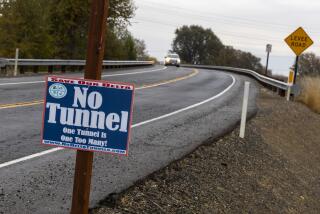Everyone’s delta
- Share via
Early last week, Gov. Arnold Schwarzenegger’s water plans looked to be headed down the path of universal healthcare. A Feb. 21 meeting with Sen. Dianne Feinstein (D-Calif.) raised hopes that a bipartisan water bond might surface in Sacramento. But then rumors that the governor would begin work on a peripheral canal in the Sacramento-San Joaquin River Delta sent Northern Californians into fits. Radio ads warned ominously of a “water giveaway” to “a few wealthy Southern California corporations.” Senate President Pro Tem Don Perata (D-Oakland) and two colleagues said they were “shocked” and found it “difficult to negotiate seriously ... in view of this.”
Responding, Schwarzenegger did outline plans to study “conveyance” options for the delta. But he also vowed to continue environmental repairs and proposed cutting per capita water use in the state 20% by 2020. The senators seemed mollified. “You cannot declare an end to the water wars,” one veteran marveled, “but [they are] more civilized than they were 24 hours ago.”
In California water politics, things don’t get much better than that. Especially when it comes to the peripheral canal, the very name of which unsettles old-time Northern Californians.
The fragile Sacramento-San Joaquin River Delta is home to more than 700 native species, half a million people and 1,100 miles of levees. California transports water to 25 million people through the delta, pumping it through the region’s waterways and into the California Aqueduct. This has been devastating to the local ecosystem. Last year, a judge shut down the pumps when the population of the delta smelt crashed.
Because disruptions in the delta mean diminished water supplies -- it has been estimated that the smelt shutdown will cut exports from the region by a third -- engineers during the 1960s proposed building a canal to connect the Sacramento River directly to pumps at the southern end of the delta. The idea was to separate flows from threats such as earthquakes, floods and environmental edicts. The peripheral canal, as it became known, has been a lightning rod ever since. Widely viewed as a Southern California water grab, it was defeated in a 1982 initiative campaign by a 3-to-2 margin.
Today, thanks to new research, we know that building a canal might not be a bad thing for the delta’s ecosystem -- especially if it’s accompanied by statewide conservation and mitigation efforts. A peripheral canal might stabilize the delta and help restore its fragile environment, while also protecting a reasonable volume of exports to Southern California and the other parts of the state that rely on delta water.
For that to work, Northern California must abandon its reflexive opposition to the canal. Maintaining the status quo -- a strategy the governor says he will also evaluate -- probably is not a realistic option. If climate change or a natural disaster were to level the delta and contaminate the water supply, a less-optimal, slapdash fix might worsen the situation.
Here in Southern California, our responsibility is to learn why the delta matters to us and to provide assurance that we won’t squander its bounty. We must make wiser decisions about development. And we must conserve. All users of delta water, from the residents of Silicon Valley to farmers in the Central Valley, must heed these hard truths.
Last week’s events suggest that Schwarzenegger and the Legislature can still move this conversation forward, evaluate options honestly and lead North and South through the tough choices that we all must make to save California’s environment and its water supply. This glass of water might be half full after all.
More to Read
Get the L.A. Times Politics newsletter
Deeply reported insights into legislation, politics and policy from Sacramento, Washington and beyond. In your inbox twice per week.
You may occasionally receive promotional content from the Los Angeles Times.










